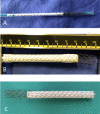How Controlled is the Expansion of VIATORR CX?
- PMID: 36826490
- PMCID: PMC10156797
- DOI: 10.1007/s00270-023-03383-4
How Controlled is the Expansion of VIATORR CX?
Abstract
Purpose: To investigate and compare the physical properties of the new generation Gore VIATORR-Controlled Expansion Endoprosthesis (VCX) to those of the predecessor VIATORR stent in an in vitro experimental setup.
Materials and methods: A total of 12 stents (8 VCX; 4 VIATORR; GORE, USA) were examined. Radial resistive force (RRF) and chronic outward force (COF) were assessed using a radial force testing machine (RX-650, Machine Solutions Inc., USA). To assess the radial forces of the VCX above 8 mm, balloon expansion was performed between cycles.
Results: All VCX stents show an abrupt decrease in COF at an external diameter of 8.3 mm; RRF decreases likewise at an external diameter of 8.5 mm. The predecessor VIATORR stent without the "controlled expansion" feature shows linear radial force reduction until full expansion at a diameter of 10 mm. The physical properties of the VCX can be altered by balloon modulation. Point of COF (RRF) reduction shifts to 8.5 mm (8.6 mm), 8.6 mm (8.8 mm) and 9.3 mm (9.6 mm) following modulation with a 8 mm, 9 mm and 10 mm balloon.
Conclusions: The VCX shows an abrupt and disproportionate decrease in COF and RRF at an external diameter of 8.3 mm, thus passive expansion to its nominal diameter of 10 mm is not to be expected. By means of balloon dilatation the physical properties of the stent can be altered, enabling customized TIPS creation. The previous VIATORR stent shows continuous COF and RRF until total expansion.
Keywords: Gore VIATORR-Controlled Expansion Endoprosthesis (VCX); Hepatic encephalopathy; In vitro mechanical test; Physical properties; Portosystemic over-shunting; Transjugular intrahepatic portosystemic shunt (TIPS).
© 2023. The Author(s).
Conflict of interest statement
The authors declare that they have no conflict of interest.
Figures






Comment in
-
Transjugular Intrahepatic Portosystemic Shunt Placement: Entering the Era of Controlled Expansion.Cardiovasc Intervent Radiol. 2023 Jun;46(6):823-824. doi: 10.1007/s00270-023-03450-w. Epub 2023 May 3. Cardiovasc Intervent Radiol. 2023. PMID: 37138106 No abstract available.
References
-
- Miraglia R, Maruzzelli L, Di Piazza A, Mamone G, Caruso S, Gentile G, Tuzzolino F, Floridia G, Petridis I, Volpes R, Luca A. Transjugular intrahepatic portosystemic shunt using the new gore viatorr controlled expansion endoprosthesis: prospective, single-center. Prelim Exp Cardiovasc Intervent Radiol. 2019;42(1):78–86. doi: 10.1007/s00270-018-2040-y. - DOI - PubMed
MeSH terms
LinkOut - more resources
Full Text Sources

